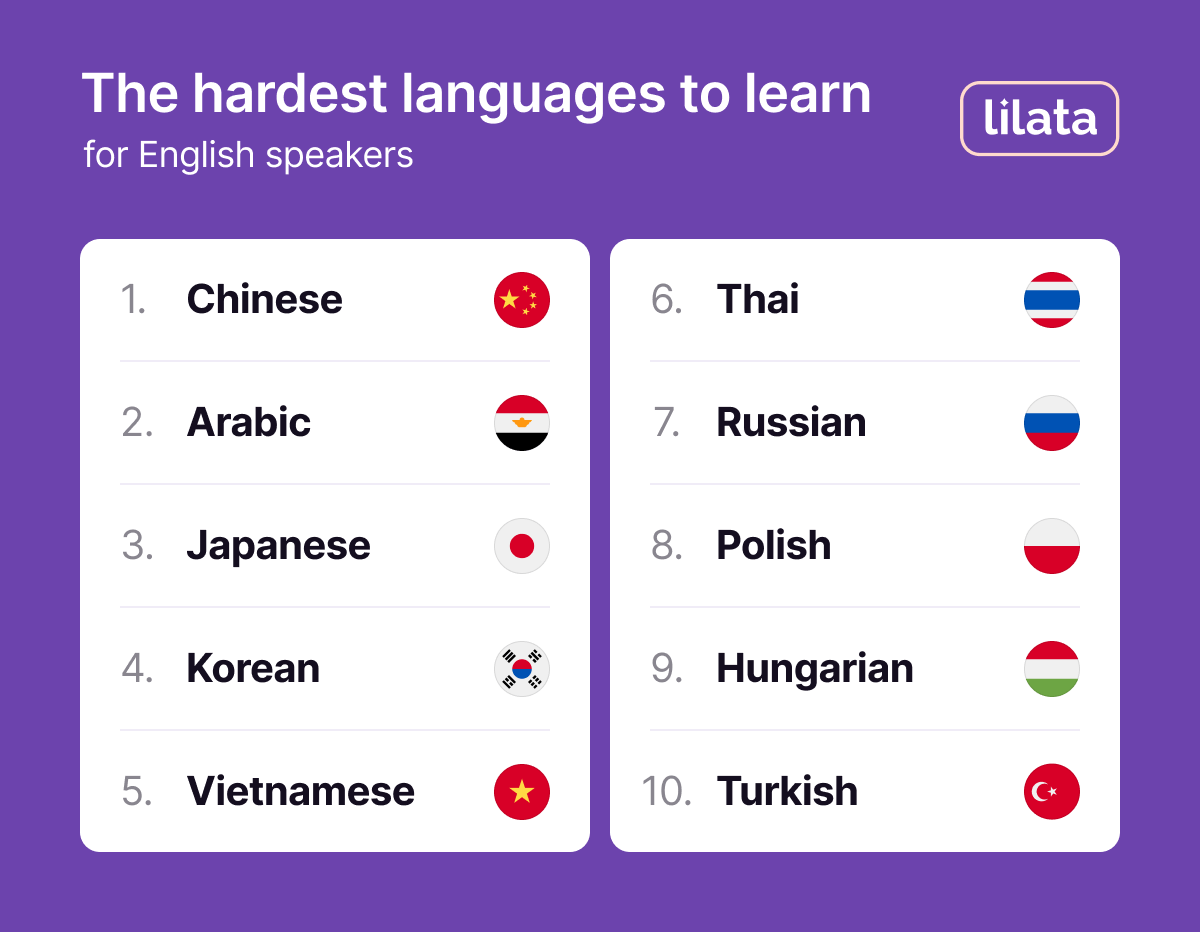

Most people tend to learn easy, popular languages like Spanish or French. However, some of the world’s most widely spoken and culturally significant languages are among the hardest languages to learn for English speakers. From unfamiliar writing systems to complex grammar rules and tricky pronunciation, they offer plenty of challenges. In this article, we’ll rank these languages and break down what makes them so difficult.
Sidenote: Check out our overview of the easiest languages to learn.
How hard are different languages to learn?
The Foreign Service Institute, a U.S. government agency specializing in language training for diplomats, categorizes languages into 4 levels based on the time needed to achieve professional proficiency.
4. Very hard languages
(88 weeks or 2200 hours to achieve proficiency)
Chinese, Arabic, Japanese, Korean.
3. Hard languages
(44 weeks or 1100 hours to achieve proficiency)
Vietnamese, Thai, Russian, Polish, Hungarian, Turkish, Tamil, Urdu, Farsi, Bengali, Hindi, Tagalog, etc.
2. Relatively easy languages
(36 weeks or 900 hours to achieve proficiency)
Haitian Creole, Swahili, Malay, German, Indonesian.
1. Easiest languages
(24-30 weeks or 600-750 hours to achieve proficiency)
Danish, Romanian, French, Swedish, Italian, Portuguese, Spanish, Dutch, Norwegian.
The hardest languages for English speakers to learn
1. Chinese

- Time to learn: 88 weeks (2200 hours)
- Number of speakers: 1.3 billion native and total speakers
- Countries: China, Taiwan, Singapore
Chinese is the most spoken language in the world by native speakers and the second most spoken language by total speakers, after English. It’s not actually a single language, but rather a family of related languages, with Mandarin being the most common. However, for simplicity, we’ll call it a language.
Chinese is considered the hardest language to learn for English speakers. One of the greatest challenges is its writing system. Instead of an alphabet, Chinese uses thousands of distinct characters, each representing a word or idea. To read relatively comfortably, you’ll need to know at least 2,000-3,000 characters.
Chinese is also a tonal language, meaning the pitch of a word can alter its meaning entirely. For example, the word “shi” can mean “lion,” “ten,” “poem,” or “to be,” depending on the tone.
If that’s not enough complexity, Chinese dialects like Mandarin, Cantonese, and Shanghainese differ significantly in pronunciation, vocabulary, and grammar, making them mutually unintelligible in many cases, despite sharing the same writing system.
2. Arabic

- Time to learn: 88 weeks (2200 hours)
- Number of speakers: 380 million native and total speakers
- Countries: Egypt, Algeria, Sudan, Saudi Arabia, Morocco, Iraq, and others
Arabic is the fifth most spoken language in the world and also one of the hardest languages to learn for English speakers. Like Chinese, it’s not a single language but a group of dialects, such as Egyptian, Levantine, and Gulf Arabic. These can differ so much that even native speakers from different regions often struggle to understand each other. To bridge this gap, Modern Standard Arabic serves as a unifying version of the language used in formal settings, media, and literature, though it’s rarely spoken in daily life.
The Arabic alphabet consists of 28 letters that change shape depending on their position in a word. Pronunciation is quite challenging, with characteristic sounds produced in the back of the throat. To complicate matters, vowels are frequently omitted in writing, forcing you to rely on context to deduce pronunciation and meaning.
The grammar of Arabic has several unique features, like a dual form for nouns and verbs. Sentence structure often places verbs before subjects, and adjectives follow nouns, flipping the typical English word order. Arabic is also written from right to left.
3. Japanese

- Time to learn: 88 weeks (2200 hours)
- Number of speakers: 123 million native and total speakers
- Countries: Japan
Japanese is widely regarded as one of the hardest languages to learn, and for good reason. It has three writing systems — kanji, hiragana, and katakana. Kanji consists of thousands of characters borrowed from Chinese, each representing a word or concept. Hiragana is a phonetic alphabet used for grammar elements and native Japanese words. Katakana is reserved for foreign loanwords and emphasis.
Pronunciation in Japanese is relatively straightforward compared to other languages on this list, as most sounds are familiar to English speakers. However, Japanese grammar is entirely different from English, with a subject-object-verb word order, no articles, and the frequent use of particles to indicate grammatical relationships between words.
Another challenge is understanding Japanese politeness levels, or “keigo.” Depending on the situation and who you’re speaking to, words and sentence structures must be adjusted to show the appropriate level of respect.
4. Korean

- Time to learn: 88 weeks (2200 hours)
- Number of speakers: 81 million native and total speakers
- Countries: South Korea, North Korea
Unlike most languages on this list, Korean has a relatively simple writing system, Hangul, which was specifically designed to be easy to learn by people without formal education. It consists of 24 basic letters that combine into syllable blocks.
What makes Korean hard is its grammar and pronunciation. Korean uses a subject-object-verb word order, which feels unusual to English speakers. It also relies heavily on particles — small words attached to nouns to show their role in a sentence. Adding to the complexity, verbs are conjugated based on tense, politeness level, and formality, making sentence structure highly context-dependent.
Korean pronunciation can be tricky too, as certain consonants, like “l” and “r,” change their sound depending on their position or neighboring letters. Vowels are also challenging and require a lot of practice to distinguish subtle differences in pronunciation.
5. Vietnamese

- Time to learn: 44 weeks (1100 hours)
- Number of speakers: 85 million native and total speakers
- Countries: Vietnam
Vietnamese is one of the most common languages in Asia and the U.S. It’s difficult to learn due to its 6 tones, which can completely change the meaning of a word. For instance, the word “ma” can mean “ghost,” “mother,” “but,” or “rice seedling,” depending on how you pronounce it.
The Vietnamese writing system, however, is more accessible than many other Asian languages. It uses the Latin alphabet with diacritics to mark tones and pronunciation.
Grammar in Vietnamese is relatively simple. There are no verb conjugations or noun declensions, and tenses are often indicated by context or time words, like “yesterday” or “already.” However, the sentence structure and use of classifiers — words used to categorize nouns — can be tricky.
6. Thai

- Time to learn: 44 weeks (1100 hours)
- Number of speakers: 21 million native, 61 million total speakers
- Countries: Thailand
Thai is one of the hardest languages in the world primarily because of its tonal nature. With 5 distinct tones, the pitch used when pronouncing a word can completely change its meaning. For instance, the word “mai” can mean “new,” “wood,” “silk,” “burn,” or “no”.
The Thai writing system adds another layer of difficulty. It uses its own unique script with 44 consonants, 18 vowels, and 6 diphthongs. Letters often change their pronunciation based on their position in a word. There are also no spaces between words in written Thai.
The grammar, however, is more straightforward. There are no verb conjugations, noun declensions, or articles. Instead, context and particles are used to indicate tense and grammatical relationships. While this simplifies things a bit, sentence structures and word order are still quite different from English.
7. Russian

- Time to learn: 44 weeks (1100 hours)
- Number of speakers: 148 million native, 255 million total speakers
- Countries: Russia, Ukraine, Belarus, Kazakhstan, and others
Russian has the most native speakers in Europe. It’s hard for English speakers mainly due to its complex grammar and unfamiliar alphabet. It uses the Cyrillic script, which has 33 letters, some of which resemble Latin letters but produce completely different sounds. For instance, “B” in Cyrillic is pronounced like “V,” and “P” is pronounced like “R”.
Other aspects of Russian pronunciation can be tricky too. Stress patterns are unpredictable and often change the pronunciation of vowels. For example, the letter “o” sounds like “ah” when unstressed. Additionally, Russian has many consonant clusters that are hard for English speakers to articulate.
Grammar is where Russian truly tests learners. It has six grammatical cases, which means nouns, pronouns, and adjectives change their endings based on their role in a sentence. Verbs also follow complex rules, including the use of aspect to distinguish between completed and ongoing actions.
8. Polish

- Time to learn: 44 weeks (1100 hours)
- Number of speakers: 40 million native, 43 million total speakers
- Countries: Poland
Polish is another Slavic language known for its challenging grammar and pronunciation. It uses a Latin-based alphabet, but the addition of diacritic marks creates unique letters and sounds. For example, “ł” is pronounced like “w” in English, and “cz” is pronounced like “ch.”
Pronunciation can also be daunting due to Polish’s infamous consonant clusters. Words like “szczegół” (detail) and “przestrzeń” (space) challenge even the most adept learners. Fortunately, stress patterns are predictable, as it usually falls on the second-to-last syllable.
Polish grammar is complex, with seven grammatical cases that require nouns, pronouns, and adjectives to change their endings depending on their role in a sentence. Verbs also vary based on aspect, tense, and even gender, adding to the difficulty.
9. Hungarian

- Time to learn: 44 weeks (1100 hours)
- Number of speakers: 14 million native and total speakers
- Countries: Hungary, parts of Romania
Hungarian earned its reputation as a hard language to learn mainly due to its complex grammar and unique vocabulary. As part of the Uralic language family, it has little in common with English or other European languages related to it.
The Hungarian alphabet uses Latin script, but it includes unique letters and digraphs like “sz”, which is pronounced as “s.” Hungarian also has 14 vowels with subtle distinctions in length and pronunciation.
Hungarian grammar has around 18 grammatical cases, which modify nouns based on their role in the sentence. While this sounds daunting, many cases act like prepositions in English. Additionally, Hungarian uses vowel harmony, meaning suffixes must match the vowels in the root word.
10. Turkish

- Time to learn: 44 weeks (1100 hours)
- Number of speakers: 84 million native, 90 million total speakers
- Countries: Turkey, Cyprus
Turkish has an interesting way of building words — by adding suffixes to a root word to create long, complex constructions. For instance, “evinizden” means “from your house,” where “ev” (house) is combined with suffixes for possession and direction. Turkish also uses vowel harmony, meaning suffixes must match the vowels in the root word according to specific rules.
The Turkish alphabet is based on the Latin script, making it more familiar to English speakers compared to many other languages. However, it includes extra letters like “ç,” “ş,” and “ı” that represent sounds that don’t exist in English.
Turkish grammar follows a subject-object-verb word order, which can feel unnatural. Additionally, there are no gender distinctions, but verbs and nouns can take on numerous forms depending on tense, aspect, and mood.
The data on speaker numbers and countries comes from the Ethnologue 2024 report.
Infographic




